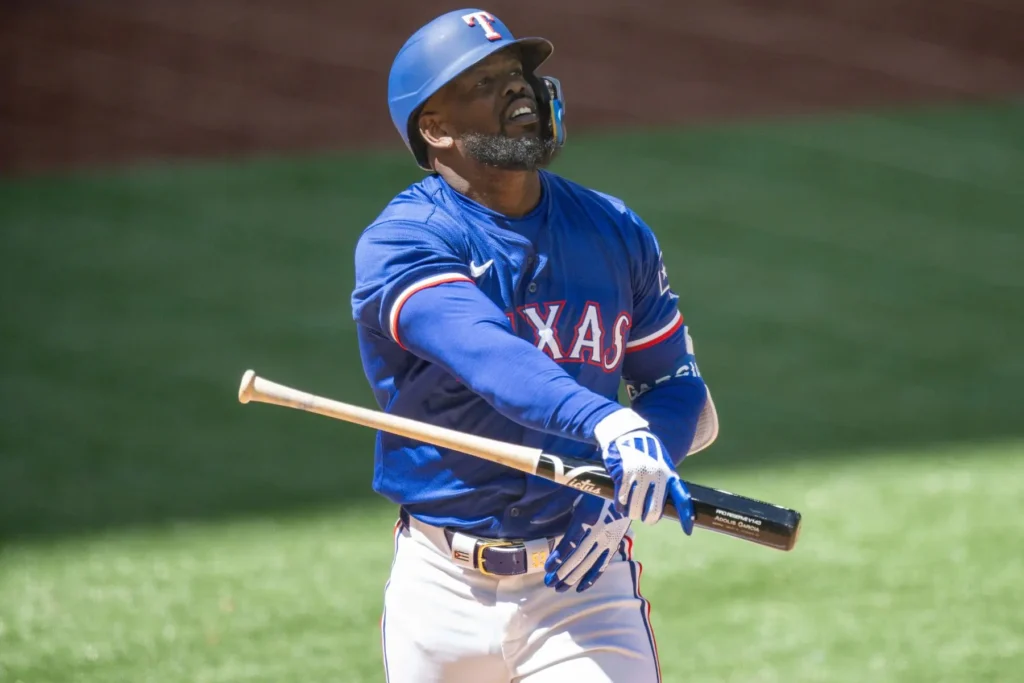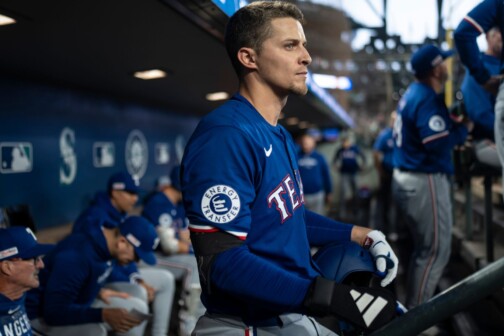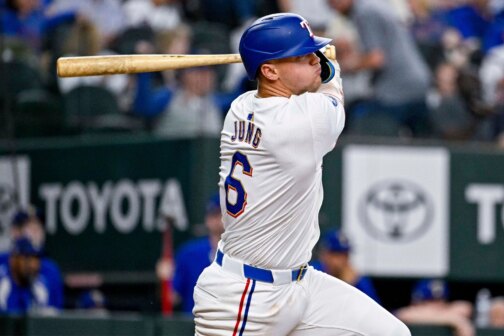Stuck on the seesaw of mediocrity, the Rangers’ title defense is feeling precarious. With 81 games down, exactly half the season, fans are straining to see the outline of that unstoppable machine from last October. And that’s because the lineup’s roaring horsepower has fallen mostly silent.
The Rangers’ bats have been 9 percent worse than league average by the all-encompassing offensive metric wRC+, ranking 23rd in MLB just a year after fielding the sport’s fourth-best lineup. With a revolving-door pitching staff that, frankly, has held its own about as well as one could have hoped, the offensive downturn must take the blame for a 37-44 record and what has shaped up as an uphill climb to the postseason. The Rangers are eight games behind the Seattle Mariners in the division and 6 1/2 games back of the final AL wild card spot. Their playoff odds are down to 10.3 percent at FanGraphs, the Houston Astros having sprung to life and leapfrogging them.
So the question is whether the lineup’s thrilling hum will live on only in memories, or whether it might fill Globe Life Field again in the coming days. Is there more under the hood for this team? Let’s run some diagnostics and listen for hope.
First, let’s just say this: it’s not out of the realm of possibility to flip a switch and rev up the offense for the rest of the season. You don’t have to dig back far in the history books to find an example of a sputtering first-half offense that turned into a behemoth. The 2023 Astros that Texas vanquished in the ALCS ran a .723 OPS in the first half, a hair below average, then blasted to an .823 OPS, good for a 127 wRC+, in the second half.
But that sort of turnaround doesn’t typically just materialize. There tend to be signs, reasons, hints of explanation. Plus, trajectory isn’t going to count as a positive sign on the team scale. June has been worse than May, which was worse than April.
The health outlook could lead to some improvements, yet there’s no missing Jose Altuve here. The return of Josh Jung, at least temporarily sidetracked, would be a welcome development (even if expectations should tempered for what he’ll provide). Beyond that the only regular missing is Evan Carter, who was struggling mightily before hitting the injured list.
The Rangers are also not suffering from any particularly glaring spell of bad luck. The team BABIP—batting average on balls in play—is below the norm at .277, but not wildly out of line in what has been a down offensive season league-wide. Statcast’s expected offensive numbers, derived from exit velocities and launch angles, have the Rangers right in line with their standing.
Even those theoretically blameless issues aren’t guaranteed to resolve themselves, as the 2023 San Diego Padres can tell you, but they would brighten the outlook.
Instead, the Rangers are dealing with a true backslide, the uncomfortable questions no longer scratched out in pencil, but written in the ink of results that will be apparent no matter how the next 81 games go.
Sometimes, peak performance means stretching the limits, pushing to places where you cannot go any, ahem, higher. The 2024 Rangers are living the flip side of the 2023 Rangers.
A rebound will require at least one of two things, and possibly a combo of both: a selection of sluggers need to approach their 2023 career years or young players need to level up. File both under “very possible, far from guaranteed” in baseball’s ever-swirling game of adjustments.
Last year’s club got above-average lines, by wRC+’s estimation, from nine of the 10 hitters who had the most plate appearances. This year’s team is working with above-average performances from only three of its 10 most-used hitters, one of whom is Josh Smith, understudy turned star in what used to be Ezequiel Duran’s quiet savior role.
Corey Seager has been, of course, one of the strong performers, even with overall numbers below his usual standards. Marcus Semien has not. His water-treading is slightly more concerning at age 33, coming off one of the heaviest plate appearance loads by a player in a season in MLB history, but his all-around game remains self-evidently valuable.
The cylinders misfiring most noticeably are Adolis Garcia and Jonah Heim, who share a specific problem that feeds into the Rangers’ brand of disappointing baseball: they are miserable against fastballs.
Texas is the worst team in baseball against fastballs thrown 96 mph or harder, batting a limp .177/.243/.283. Leody Taveras has been the worst hitter in MLB against the heat, with Garcia and Heim not faring much better. Contrary to what fans might believe, the Rangers have not been notably bad with runners on or in scoring position. Their struggles are most pronounced in late and close situations, when they are more likely to be facing a reliever who flirts with triple digits.
Expectations are a tricky thing, especially for a titan of last year’s World Series run. Garcia entered last season with a power-first, everything-else-last career line of .243/.290/.449. He burnished a legacy last season by mauling sliders, but he now feels like a problem as he experiences the gravity of his longstanding strengths and weaknesses. His less spectacular track record outside of 2023 reflects what projections systems see going forward: an above-average offensive player, but no All-Star. That would simultaneously beat his current slump-marred line and disappoint everyone who watched him rip baseballs into the stands seemingly at will last October.
Meanwhile, although Wyatt Langford tracked below expectations early in the season, the prodigal rookie has looked far more comfortable since returning from injury in late May. He has a 116 wRC+ since May 28, including his first two over-the-fence homers and an impressive 16.2 percent strikeout rate. But with Garcia, Heim, Semien, and Nathaniel Lowe all hitting well below last season’s marks, the 21-year-old not only must sustain that production but probably increase it further to offset the decline around him in a serious way.
That’s a tough ask even of one of the most precocious prospects in baseball, yet it still feels more reasonable than expecting Carter to hit the gas whenever he returns from a back injury that’s sidelined him since the early part of the month. Texas’ surprise No. 3 hitter from October has looked every bit a player who came into the year with just 31 career regular-season games above Double-A, turning in a 78 wRC+ and getting his plate appearances slashed against lefty pitching. There’s still plenty to be excited about long-term, but that’s little comfort in the here and now, as the Rangers fight to stay in the postseason hunt.
Sustaining success will require shifting gears. However herky-jerky, the important thing is to have more than one speed, even if that’s not what a defending World Series champ wants to hear. A roar could still emerge in 2024, with Langford and Jung and Smith in the middle of things alongside Seager and Semien. But the Rangers are quickly learning that the next winning lineup might not look or sound like the last one.
Author






